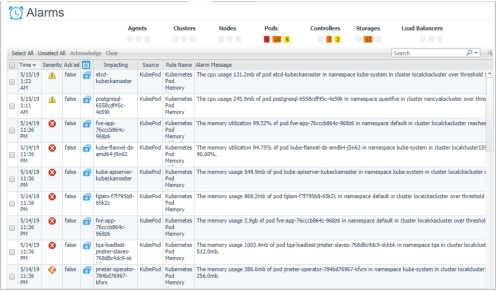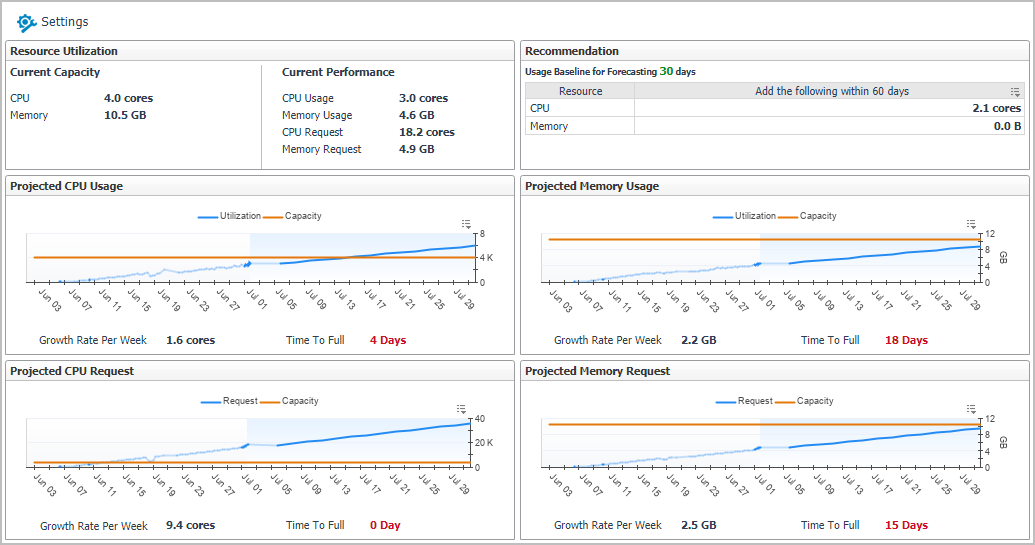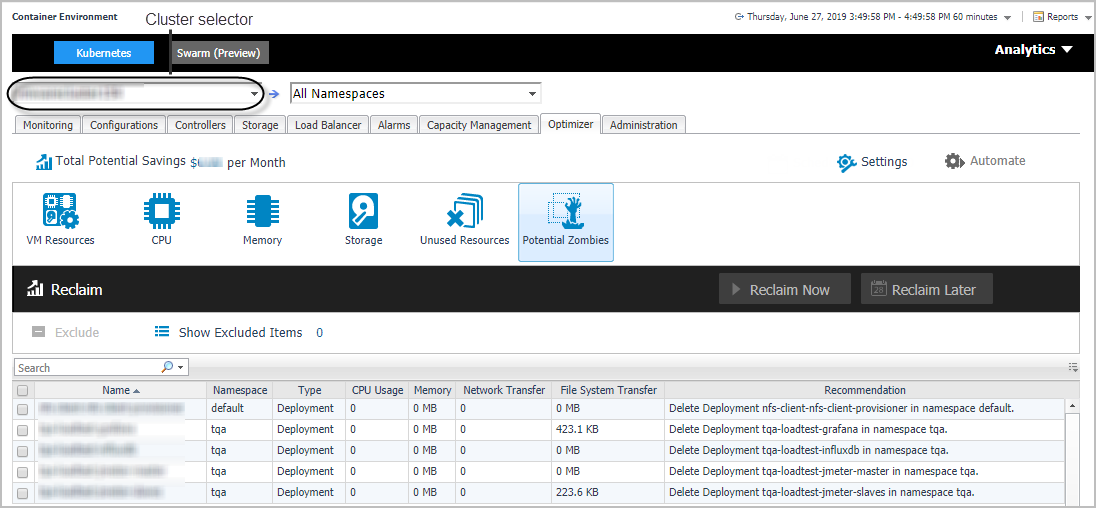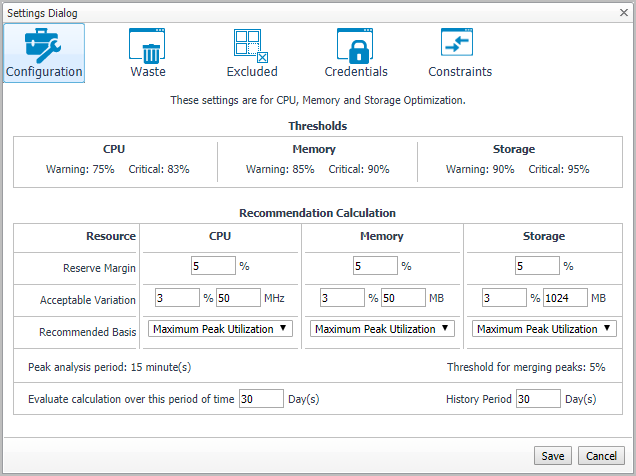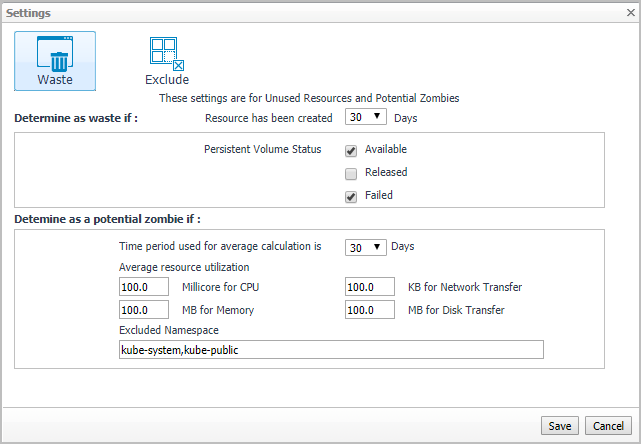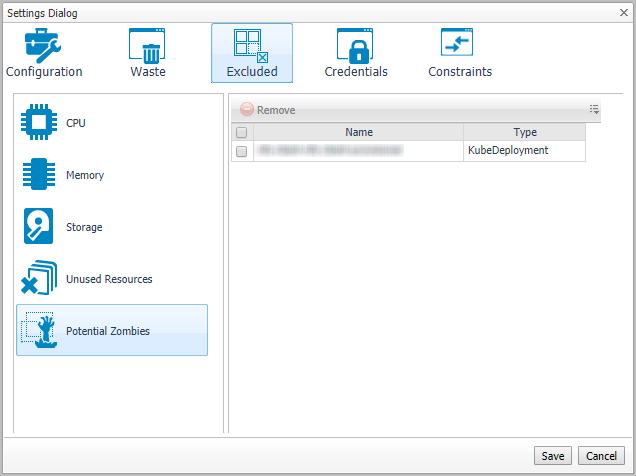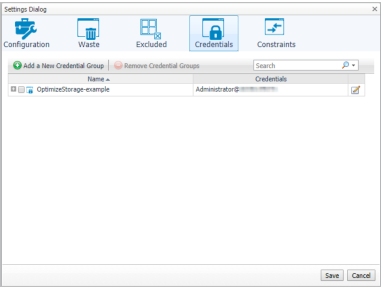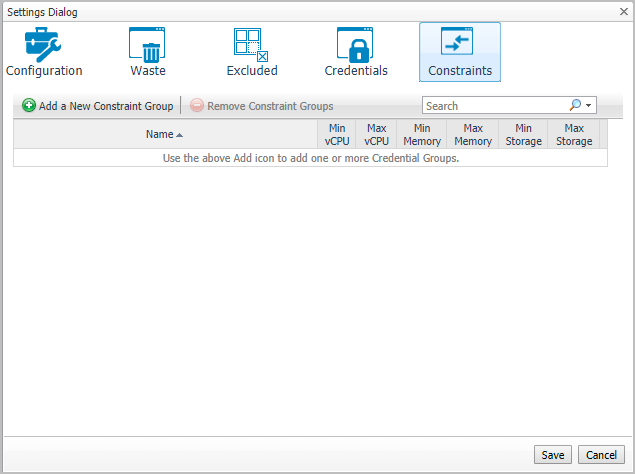Alarms
The Alarms dashboard displays a list of alarms generated against the monitored Kubernetes environment. Use this view to quickly identify any potential problems related to a specific Kubernetes component.
Capacity Management
The Capacity Management dashboard contains the following fields:
|
• |
|
|
• |
Baseline for Forecasting: Defines the historical period used for the calculations of metric views, current capacity, and recommended resources in the Resource Utilization view. The default value is 60 Days Trending. |
|
• |
Time Frame: Defines the predicted period for calculating metric views, current capacity, and recommended resources in the Resource Utilization view. The default value is Next 30 Days. |
|
• |
Current Capacity: current resource capacity. |
|
• |
Current Performance: current resource usage. |
|
• |
Projected CPU/Memory Usage: Shows the historical data and the predicted usage trend within the configured future period. |
|
• |
Projected CPU/Memory Request: Shows the historical data and the predicted request trend within the configured future period. |
|
• |
Utilization: usage. |
|
• |
Capacity: upper bound which the usage might reach. |
|
• |
Growth Rate per Week: growth amount of the resource. |
|
• |
Time to Full: how many days the resource usage/request will reach the capacity. |
|
NOTE: If a value Never is displayed at Time to Full, which means the usage/request trend is declining and the usage/request will never reach the capacity. |
Optimizer
The Optimizer view appears after clicking Container > Kubernetes > Optimizer.
The Optimizer view includes the following elements:
|
• |
Cluster Selector. The cluster selector is located at the top of the Optimizer view and allows you to select the environment that you want to optimize. |
|
• |
|
• |
Automate. Use the Automate menu to set the criteria for automatically sending recommendations for improvements. Currently, this button only functions for CPU and Memory when a VMware cluster is selected. |
|
• |
Reclaim Now and Reclaim Later buttons. System administrator can select a VM from the list and review the Reclaiming Savings bar for information about how many resources can be reclaimed. |
|
NOTE: The Reclaim Now and Reclaim Later buttons are enabled only after selecting a checkbox from the table. Currently, the two buttons only function for VM Resources, CPU, and Memory when a VMware cluster is selected. The Automate, Reclaim Now, and Reclaim Later buttons are displayed only when a VMware cluster is selected. |
|
• |
Exclude button. Select an object you want to exclude from the table to enable the Exclude button, and click Exclude. Then, this object is added to the list of excluded objects under a specific category. |
|
• |
Show Excluded Items button. Click the Show Excluded Items button to view the excluded objects. The Settings dialog box appears. For more information, see |
|
• |
VM Resources/VM Resizing. Shows instance or virtual machine name, utilization, recommendations for both CPU and memory resources, and savings. |
|
• |
CPU. Shows instance or virtual machine name, utilization, recommendations for CPU resource, and estimated savings. |
|
• |
Memory. Shows instance or virtual machine name, utilization, recommendations for memory resource, and estimated savings. |
|
• |
Storage. Shows virtual machine name, utilization, storage and modify recommendations, and savings. |
|
NOTE: VM Resizing will be displayed when a cloud cluster is selected. VM Resources, CPU, Memory, and Storage will be displayed when a VMware cluster is selected. |
|
• |
Unused Resources table. Detects and shows those unused resources in container environment. |
|
• |
Potential Zombies table. Detects and shows the potential pod controllers in container environment, including Deployment, Daemon Set, Stateful Set, Replication Controller, as well as Pod that is not managed by any Pod Controller. |
Settings
The Configuration tab provides the recommended settings for CPU, memory, and storage optimization.
|
• |
Thresholds. Provides the values of a resource metric that define the Warning and Critical levels (for CPU, memory, and storage). |
|
• |
Recommendation Calculation area. Allows you to define the following parameters for optimizing the CPU, memory resources in your environment, Storage resources not supported at current version: |
To save any changes made to the Configuration settings, click Save at the bottom of the tab.
The Waste tab allows you to configure the settings for determining resources wasted in your environment. These include unused resources and potential zombie Pod controllers.
|
• |
Determine as waste if: used to filter Unused Resources. |
|
• |
Resource has been created [time] days: Resources that has been created more than the set days will be considered here. |
|
• |
Persistent Volume Status: By default, select Available and Failed. For detailed information, go to https://kubernetes.io/docs/concepts/storage/persistent-volumes/#phase. |
|
• |
Determine as a potential zombie if: used to filter Potential Zombies. |
|
• |
Time period used for average calculation is [time] days: The average metrics for the pods are calculated, so a time range should be set to calculate the average value. |
|
• |
Average resource utilization: only if a pod's metrics satisfy all the conditions, it will be considered to be a potential zombie pod. |
|
• |
Excluded Namespace: pods in the namespace can be excluded in the Potential Zombies check. |
To save any changes made to the Waste settings, click Save at the bottom of the tab.
The Excluded tab allows you to remove a resource from the list of excluded objects. The Excluded tab includes the following information:
To remove resources from the list of Excluded objects, select the check boxes for these resources and click Remove. To save any changes made to the Excluded settings, click Save at the bottom of the tab.
The Excluded tab can also be accesses by clicking Show Excluded Items on the Optimizer tab.
This tab is available in VMware environment. The Credentials tab allows you to add, edit, and remove credentials groups. This tab is only for the Storage rightsizer.
This tab is available in VMware environment. The Constraints tab allows you to set custom thresholds for select objects in the environment. These recommendations are displayed in the Optimizer tab > VM Configuration/ CPU/ Memory/ Storage views > Modify Recommendation column. Use this tab to add, edit, and remove constraints groups.

